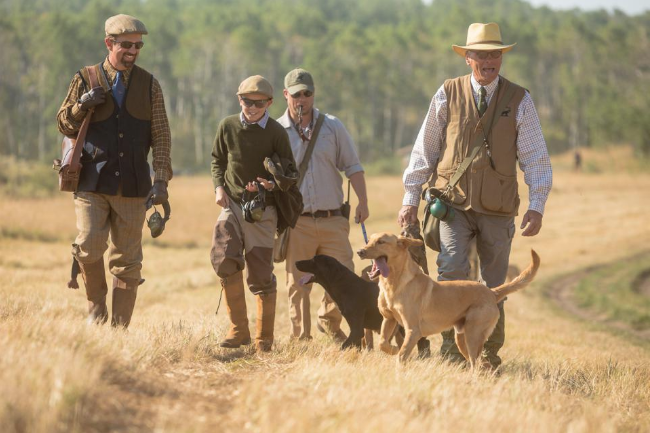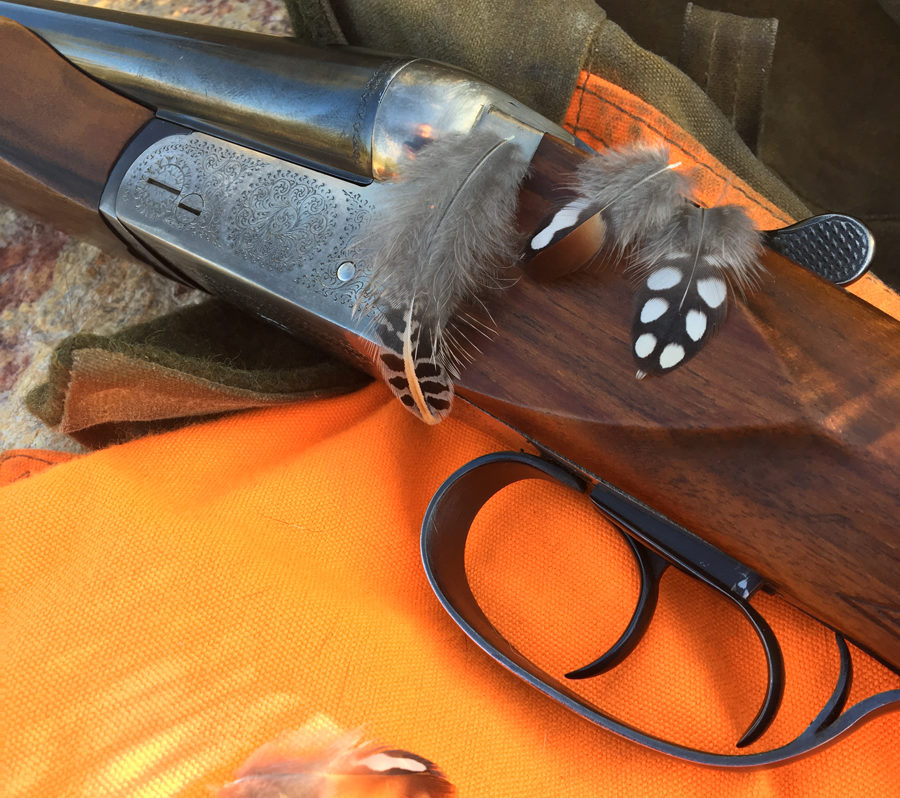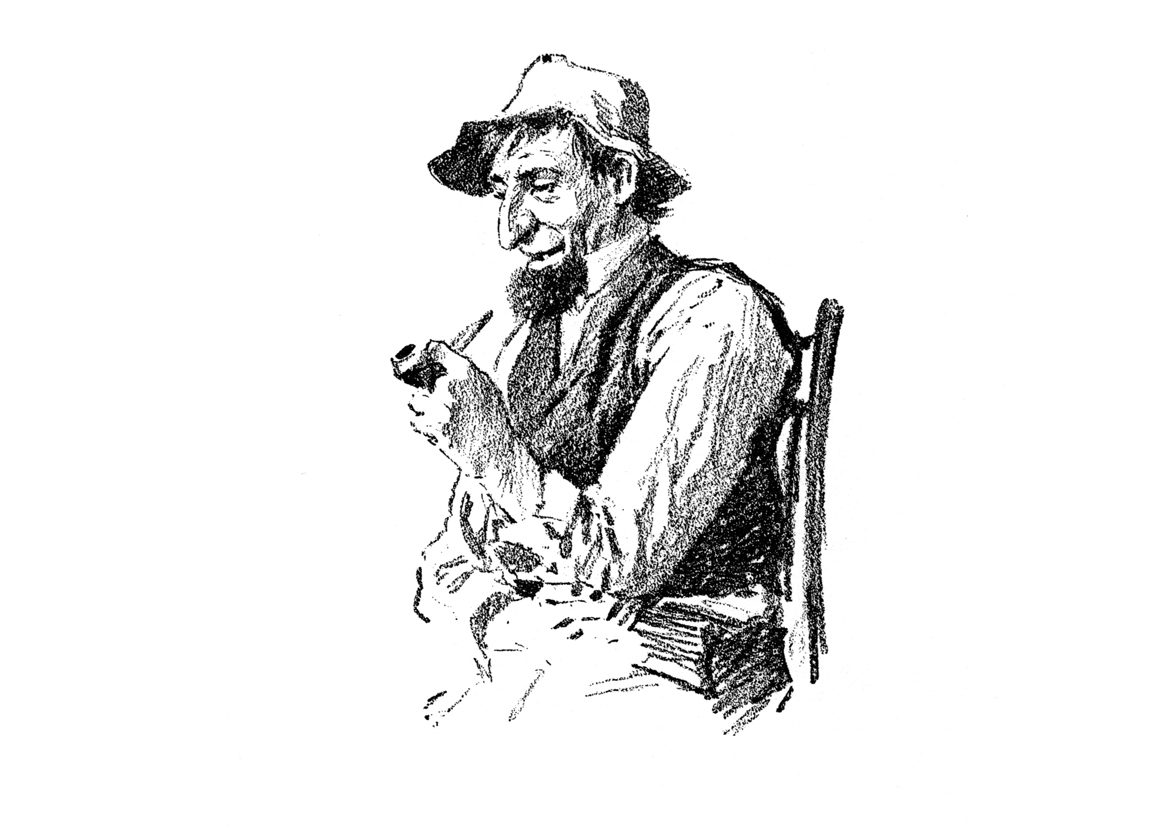How the European sport of royalty has come to the American West
What if you could enjoy driven red-legged partridge in stunning and steep terrain, the kind of presentation made famous in the hills of Spain…but without the jet lag? That was the notion of Lars Magnusson, a former shooting instructor turned European-American driven bird raconteur whose Blixt & Company has built a dedicated following among domestic double gun aficionados.
He scoured the American West for just the right mix of open space, cover and ideal terrain from which to present tall, challenging birds—both red-legged partridge and pheasants. While driven in Idaho might lack the history and pageantry of the European shoots, the Blixt experience includes plenty of strong flying birds and its own take on lodging and dining opulence that is the hallmark of this top-of-the-food-chain venture the world over.
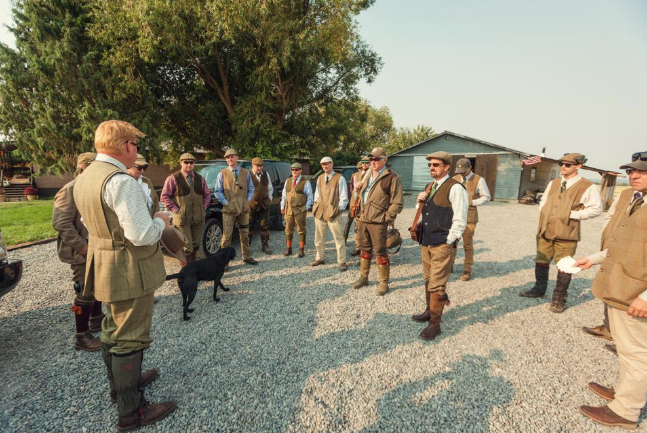
Magnusson (left) instructs shooters on safety protocols before a drive commences. – Chris Dickinson Photography
For many American shooters who have tried the Blixt Idaho presentation, there are plenty who now forgo the time and hassle of flying abroad to enjoy driven birds in exchange for the Blixt blessings. Despite his share of skeptics, Magnusson was able to pull off the unimaginable, for he took a distinctly European endeavor and gave it an American flair all the while preserving an authentic driven experience.
I am one shooter keen to try his offering and bring along my son Luke and our budding Wildrose British Lab, fresh out of university at the Wildrose campus near Oxford…Oxford, Mississippi, that is. Blixt and Wildrose have built an alliance whereby their dogs are used in picking up scores of birds shot throughout the course of a driven season. Seems only fitting that British Labs would be employed for this most European form of shooting. Our Lab, Dash, is several weeks into the Blixt-Wildrose boot camp and Luke is eager to reconnect with his pup while she finishes her work at this Dogwarts of sorts, where Wildrose staff finish their training wizardry thanks to the opportunity for dogs to recover a lifetime worth of birds in just a short season.
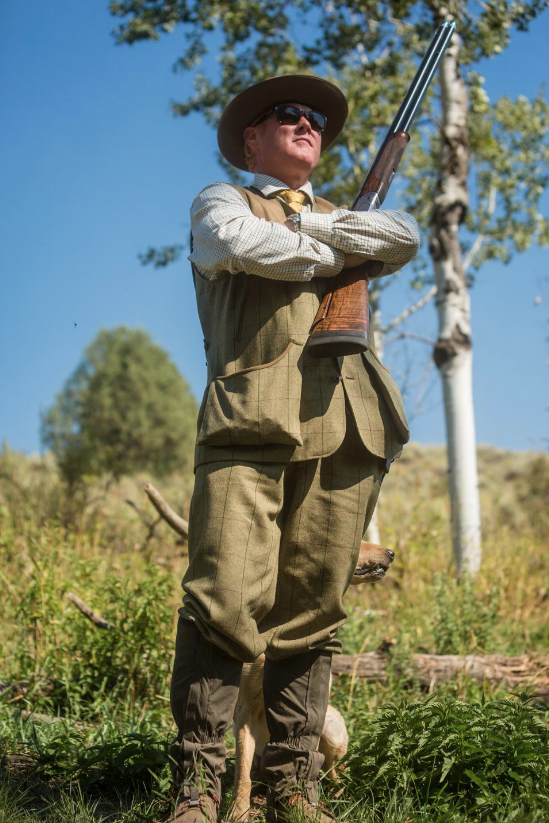
Magnusson readies for a line of beaters to move a cloud of partridge over the shooting line as part of the autumn ritual at Idaho’s Blixt & Co driven shoot. – Chris Dickinson Photography
We head to Teton Valley, Idaho, just over the Wyoming state line, which is a short drive from Jackson Hole. The idyllic mix of rolling hills with poplar and evergreen stands along the slopes and grain stubble below provides the perfect prescription for driven shooting, and Lars recognized just how ideal it was the instant he saw it. As we arrive at ground zero for Blixt, we drive past a compound which consists of a series of private chalets, all part of the beautiful River Rim and Overlook Lodge.
Inside the main lodge, we find classic rustic elegance with plenty of comfortable sitting areas and premium art. An open living room with towering ceilings, massive stone fireplace and commanding views of a small stream below and the Tetons in the distance quickly give you the sense that this venue may not be as good as some of the best shoots in Europe…it may be better. And while Idaho weather is famous for throwing a surprise punch or two, for the most part it is a sunny and arid environment—a far cry from the wind and rain so common during shoots in the British Isles.
Magnusson is a Swedish immigrant who met his beautiful American wife Jennifer, fell in love, and together built the Blixt shooting business. Their clients have, for the most part, become extended members of the family, returning each autumn to celebrate the latest rendition of Magnusson’s Idaho driven experience.
We load up a series of black Range Rovers as the party disembarks from the lodge for a place called Twin Peaks, a picturesque driven destination about a 30-minute drive where the beaters are already waiting. Soon we are staggered in a long line, perhaps 35 yards between each shooter. First a trickle of partridge cross in front, the warm up birds sent to see how much rust there is on your swing. These are red-legged partridge, brought in as eggs from France. They’re hatched and raised stateside before being released on the Blixt grounds.
Unlike many shoots across the U.S. that use the word “driven” or “simulated driven” in their descriptions, the Blixt experience is a true driven shoot. That is, the birds are scattered throughout the fields and are pushed over the guns by a line of flag-toting beaters, which provides the most authentic driven shooting experience on the continent. What you get are strong flying birds that have spent plenty of time in the air and know the terrain and how to use it.
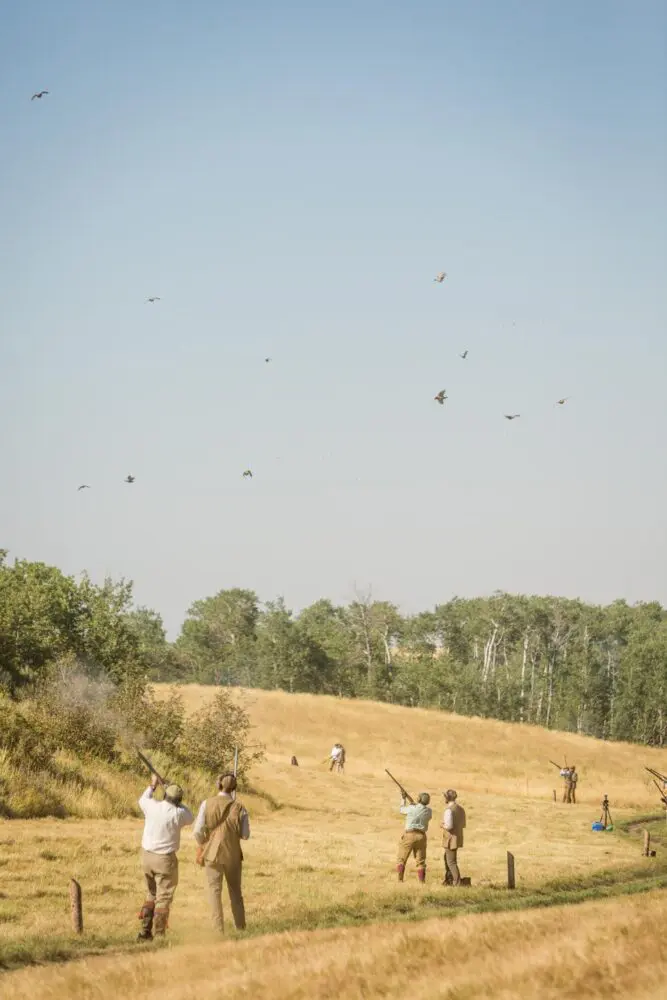
Red-legged partridge pass over a line of guns in one of several beats held each day of a Blixt driven shoot. This form of shooting originated in the British Isles but Magnusson has replicated the experience in the stunning landscape of Idaho. – Chris Dickinson Photography
Sometimes a drive aligns perfectly with your strength as a shooter with large numbers of birds passing through your gunning sweet spot. The second beat of the day is just such an occasion for me. As a left hand shooter, left to right crossing shots—pulling the stock into my face on the swing—has long been my favorite target. By favorite I mean I tend to hit more than I miss. Partridge after partridge cross in my groove, the fallen birds making me feel like Sammy Sosa being pitched a steady diet of inside fastballs.
After the beat, we head to a field lunch where white canvas tents with wooden floors and an elegantly set table is waiting for us. It is a western spin on the driven experience, a glamping affair amid a stand of aspen complete with a gourmet lunch and a beautiful cobalt sky with lemon drop aspen leaves shimmering in the breeze. And did I say there are hammocks for those who want to have a siesta before returning to the afternoon shoots?
Still reveling in the success of the last drive before lunch, the first beat following lunch finds me at the bottom of a hill sandwiched between two tall stands of aspen. My shooting window is about a bus length wide and the birds are tall—stretch your barrels long. It also seems as if someone is goosing them as they rocket overhead, for somehow they manage to engage another gear, propelling them faster than I remember the species being able to motivate. No one said it was going to be easy.
The variety of beats offered across Magnusson’s territory is impressive with more than 50 different drives in a wide range of terrain, testament to both the landscape and his use of it. There is gently rolling farm country as well as another property with steep canyons that will test even the most experienced driven shooters. By test I mean humble.
Magnusson saves his best for last, however. As we start the final beat, the sky is suddenly covered with hundreds if not more than a thousand partridge and pheasants, as if some kind of impromptu upland bird migration. It is a moment that you wish could become slow motion to savor and extend it in all its glory. Wouldn’t it be grand if such a scene could last for an hour or two…hell, days for that matter?, I think to myself. Every great beat has a climax when overwhelming numbers of birds cover the sky and you frenetically scramble to maximize the richness of the opportunity. When it ends—and it must—there’s either the satisfaction of having shot well or a frustration in missing an opportunity to be a King for a Day.
At Blixt, you can count on the royal treatment either way.
This article originally appeared in Forbes. Follow Sporting Classics TV host Chris Dorsey at Forbes.
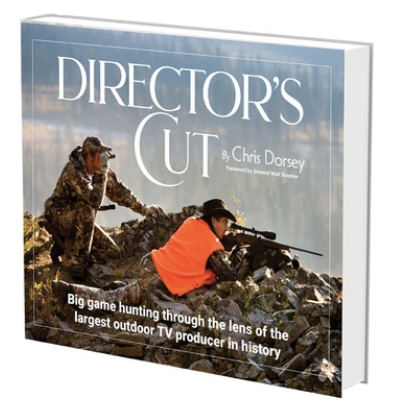 The World Of Sporting Literature Has A New Classic from one of the planet’s most widely traveled hunters. Director’s Cut…Big game hunting through the lens of the largest outdoor TV producer in history, is a book and film production more than 15 years in the making. Author and Executive Producer Chris Dorsey, along with a team of the world’s best sporting life photographers and cinematographers, embarked on expeditions to distant corners of the globe to create an indelible portrait of big game hunting.
The World Of Sporting Literature Has A New Classic from one of the planet’s most widely traveled hunters. Director’s Cut…Big game hunting through the lens of the largest outdoor TV producer in history, is a book and film production more than 15 years in the making. Author and Executive Producer Chris Dorsey, along with a team of the world’s best sporting life photographers and cinematographers, embarked on expeditions to distant corners of the globe to create an indelible portrait of big game hunting.
Dorsey has spent the past 25 years investigating and chronicling the animals, people and unforgettable places home to remarkable big game hunts while producing nearly 60 outdoor adventure television series. In the process, his teams amassed a library of more than 100,000 hours of HD footage and nearly 150,000 photographs, making Director’s Cut (the book and DVD) an unmatched celebration of the world of big game hunting. Buy Now

